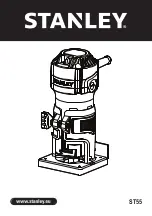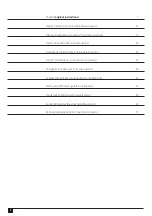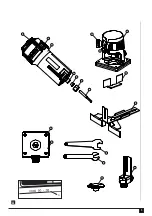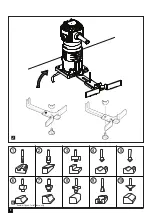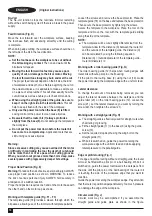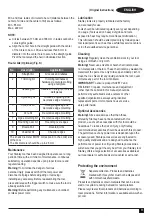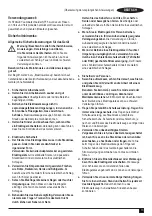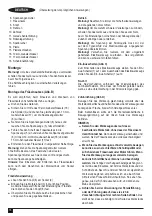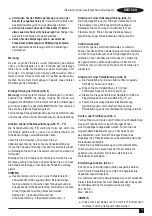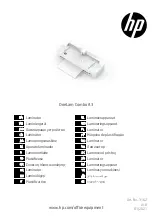
10
ENGLISH
(Original instructions)
No-Volt
The No-volt function stops the laminate trimmer restarting
without the switch being cycled if there is a break in the power
supply.
Feed Direction (Fig. D)
Move the tool forward over the workpiece surface, keeping
the tool base flush and advancing smoothly until the cutting
is complete.
When doing edge cutting, the workpiece surface should be on
the left side of the bit in the feed direction.
NOTE:
u
Set the tool base on the workpiece to be cut without
the bit making any contact.
Then on and wait until the
bit attains full speed.
u
Moving the tool forward too fast may cause a poor
quality of cut, or damage to the bit or motor. Moving
the tool forward too slowly may burn and mar the cut.
The proper feed rate will depend on the bit size, the kind
of workpiece and depth of cut. Before beginning the cut on
the actual workpiece, it is advisable to make a sample cut
on a piece of scrap lumber. This will show exactly how the
cut will look as well as enable you to check dimensions.
u
When using the straight guide or the guide, be sure to
keep it on the right side in the feed direction.
This will
help to keep it flush with the side of the workpiece.
u
Only use the power tool when the base (9) is fitted.
Losing control of the power tool can cause injuries.
u
Be aware that the router bit (7) always protrudes
slightly from the base(9).
Do not damage the template or
the workpiece.
u
Do not put the power tool down before the router bit
has come to a complete stop.
Application tools that are
still running can cause injuries.
Warning:
Since excessive cutting may cause overload of the motor
or difficulty in controlling the tool, the depth of cut should
not be more than 3 mm at a pass when cutting grooves.
When you wish to cut grooves more than 3 mm deep, make
several passes with progressively deeper bit settings.
Proper Hand Position (Fig.
E
)
Warning!
To reduce the risk of serious personal injury, ALWAYS
use proper hand position as shown. WARNING: To reduce
the risk of serious personal injury, ALWAYS hold securely in
anticipation of a sudden reaction.
Proper hand position requires one hand on the motor base with
the other hand on the motor cap as shown.
Working with template guide (Fig. F1 – F3)
The template guide (18)provides a sleeve through which the
bit passes, allowing use of the trimmer with template patterns.
Loosen the screws and remove the base protector. Place the
template guide (18) on the base and replace the base protector.
Then secure the base protector by tightening the screws.
Secure the template to the workpiece. Place the tool on the
template and move the tool with the template guide sliding
along the side of the template.
NOTE:
u
The workpiece will be cut a slightly different size from the
template. Allow for the distance (X) between the router bit
and the outside of the template guide. The distance (X)
can be calculated by using the following equation:
Distance (X) = (outside diameter of the template guide -
router bit diameter) / 2
Working with a roller bearing guide (Fig. G)
The roller bearing guide (12) helps when routing edges with
router bits without a pilot pin or ball bearing.
Fit the pilot to the routing base (9) using the nut (19). Guide
the power tool along the workpiece edge with a uni-form feed.
Lateral clearance:
To change the amount of material being removed, you can
adjust the lateral clearance between the workpiece and the
guide roller (20) on the roller bearing guide (12). Loosen the
screw (21), set the lateral clearance you want by turning the
screw (22), then retighten the screw (21).
Working with a straight guide (Fig. H)
u
The straight guide is effectively used for straight cuts when
chamfering or grooving.
u
Fit the straight guide (11) to the base (9) using the guide
screw (19).
u
Set the required stop depth using the wing bolt on the
straight guide (11).
u
While it is switched on, guide the power tool along the
work-piece edge with a uniform feed and while applying
lateral pressure to the parallel guide.
Edge or profile routing (Fig. I)
For edge and profile routing without a straight guide, the router
bit must be fitted with a pilot pin or a ball bearing. While it is
switched on, guide the power tool towards the workpiece from
the side until the pilot pin or the ball bearing of the router bit
is touching the side of the workpiece edge that you want to
machine.
Guide the power tool along the workpiece edge. Pay atten-tion
that the router is positioned perpendicularly. Too much
pressure
can damage the edge of the workpiece.
Circular work (Fig. J)
Circular work may be accomplished if you assemble the
straight guide and guide plate as shown in the figure.

